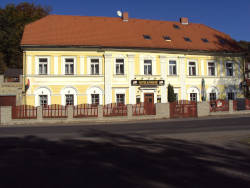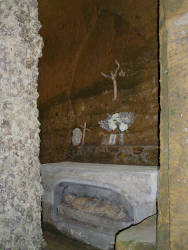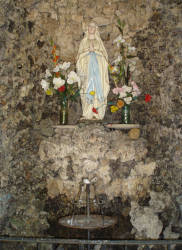Modlivý důl
Skalní kaple v Modlivém dole - Praying Mine
Useful Information


| Location: |
From Novy Bor Rd 268 southeast.
Park at Restaurace Zámeček.
(50.726201, 14.604815) |
| Open: |
no restrictions. [2020] |
| Fee: |
free. [2020] |
| Classification: |
 Monolithic Church Monolithic Church
|
| Light: | bring torch |
| Dimension: | |
| Guided tours: | self guided |
| Photography: | allowed |
| Accessibility: | no |
| Bibliography: | |
| Address: | |
| As far as we know this information was accurate when it was published (see years in brackets), but may have changed since then. Please check rates and details directly with the companies in question if you need more recent info. |
|
History
| 1704 | a groom hangs a picture of the Virgin Mary and Jesus in the valley. |
| 1760 | picture replaced with a new, consecrated one by an assistant brewer from the Skovkov brewery Metzer. |
| 1772 | the pious Countess Cervelli ordered the erection of a wooden chapel. |
| late 18th century | a chapel carved into the rock replaced the wooden chapel, financed by Countess Alžběta Kinská. |
| 1807 | statues of saints were transferred to the church in Sloup. |
| 1832 | processions revived due to the cholera plague. |
| 1836 | the sculptor Antonín Wagner from Sloup modified the facade into a Gothic form. |
| 1900 | chapel dedicated to the Virgin Mary of Lourdes. |
| 1903 | modified as a Lourdes cave. |
| 2001 | new statue of the Virgin Mary delivered and consecrated. |
Description


The hills north of Svojkov are full of weird rocks of reddish Cretaceous sandstones, which is quite common in this area. On the road from Svojkov to Sloup v Čechách, in the middle of the forest, is the historic Restaurace Zámeček. From here trails through the hills and the rocks start which lead to various strange sites.
The area has numerous sandstone-related sights. The most important are the Svojkov kameny (Svojkov Rocks) or Dědovy kameny (Grandpa’s Rocks) which form an escarpment to the south and offer a great view on the plain and the village Svojkov. The Jeskyně Poustevna are small cave houses with clearly visible doors and windows. Nevertheless, their actual use is unclear. Hlídková jeskyně is another mostly artificial cave of unknown origin and use. The cavities are too small to be rock mines, there is also no nearby building for which the rock were mined. Most likely, they were shelters for people living or working in the forest, like wood cutters.
The most famous sight is the small Lourdes chapel Modlivý důl (Praying Valley, Betgraben). It is actually a monolithic church as it was cut completely into the sandstone, including the facade, which shows gothic vaults above the entrance door. Modlivý důl is also the name of the valley, which was formerly known as Smolný důl (Tar Valley, Pechgraben). The reason was that the valley was full of charcoal burners. They created charcoal the traditional way with piles and also produced tar.
The Lourdes Grotto began with a picture of the Virgin Mary and Jesus that a groom from a nearby farm in the valley hung up on a rock face in 1704. There were many old legends about this area, and he wanted the best luck for his marriage. In 1760 an assistant brewer from the Skovkov brewery Metzer replaced it with a new, consecrated picture. Tourists began to visit the place and rumors of miracles began to spread. The pious Countess Cervelli from Svojkov ordered the erection of a wooden chapel. The supposedly miraculous picture was moved to the chapel. The first procession from Česká Lípa was organized in the same year. At the end of the 18th century, a chapel carved into the rock replaced the wooden chapel, financed by Countess Alžběta Kinská. The chapel was built by the bricklayer Josef Sacher from Svojkov.
But not everybody was happy with the chapel. The pastor in Sloup resented the fact that the faithful sometimes went to the forest instead of going to his church. The church rejected the procession to the chapel as idolatry, and the praying petitioners and other decorations were removed. In 1807 the installed statues of saints were transferred to the church in Sloup. The processions were revived in 1832 because of the plague. In 1836 the sculptor Antonín Wagner from Sloup modified the facade into a Gothic form. A painting of the Virgin Mary by Eugenie Hauptmann was placed in the chapel. Even Emperor Ferdinand V used to pray here.
Around 1900 the chapel was dedicated to the Virgin Mary of Lourdes and in 1903 it was modified as a Lourdes cave. This change was directed by Countess Kinská. But during the 20th century, many parts were damaged. In 2001 a new statue of the Virgin Mary was delivered and consecrated.
 Search DuckDuckGo for "Modlivý důl"
Search DuckDuckGo for "Modlivý důl" Google Earth Placemark
Google Earth Placemark OpenStreetMap
OpenStreetMap Modlivý důl (Svojkov)
Modlivý důl (Svojkov)  - Wikipedia (visited: 22-DEC-2020)
- Wikipedia (visited: 22-DEC-2020) Modlivý důl u Svojkova
Modlivý důl u Svojkova  (visited: 22-DEC-2020)
(visited: 22-DEC-2020) Index
Index Topics
Topics Hierarchical
Hierarchical Countries
Countries Maps
Maps